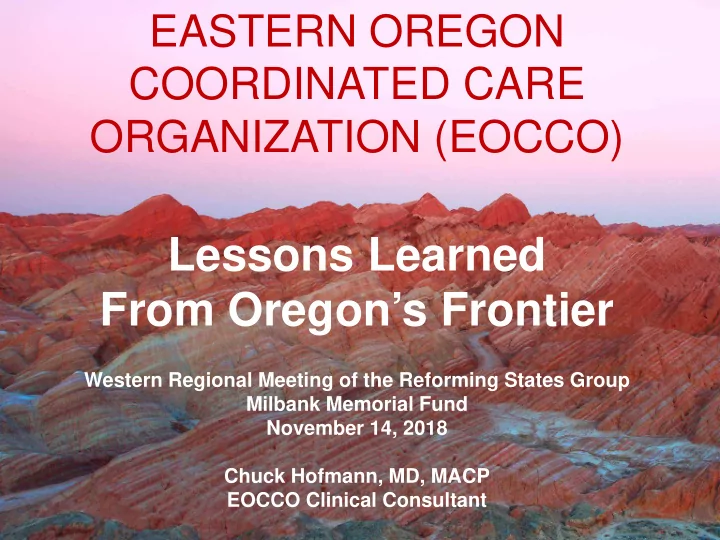

EASTERN OREGON COORDINATED CARE ORGANIZATION (EOCCO) Lessons Learned From Oregon’s Frontier Western Regional Meeting of the Reforming States Group Milbank Memorial Fund November 14, 2018 Chuck Hofmann, MD, MACP EOCCO Clinical Consultant
EOCCO 50,000 square miles (OR: 98,500 square miles) 195,000 residents (OR: 4,150,000 residents) 50,000 enrollees
EOCCO Structure • Ownership – Moda Health – Greater Oregon Behavioral Health, Inc. – Good Shepherd Hospital, Hermiston – Grande Ronde Hospital, LaGrande – St. Alphonsus Hospital, Baker City – St. Alphonsus Hospital, Ontario – St. Anthony’s Hospital, Pendleton – Eastern Oregon IPA, Umatilla County – Yakima Valley Farm Workers Clinic, FQHCs in Hermiston and Walla Walla, WA • 17 Member Governing Board – Hospital, Primary Care, Behavioral Health, Public Health, Local Elected Officials, & Lay Members • Community Advisory Councils – 12 Local Community Advisory Councils (LCACs) – 1 per county – 1 Regional Community Advisory Council (RCAC) – Responsible for Community Health Assessments and Community Health Improvement Plans • Clinical Advisory Panel (CAP) – 12 Member committee composed of Primary Care, Behavioral Health, Public Health, Dental Health – Responsible for advising Board on clinical matters
The Delivery System* – 10 Area Hospitals • 7 of 10 are Type A/Critical Access Hospitals • 5 of 10 are part of health districts • None are tertiary hospitals – Primary Care Providers • 57 widely dispersed clinics, many sole provider • 24 are Rural Health Clinics (RHCs) • 7 are Federally Qualified Health Centers (FQHCs) • 90% of members are served by certified medical homes – Additional Providers • Specialty Medical Care • Behavioral Health • Dental Health • Non-emergent Medical Transportation *Includes Oregon, Idaho & Washington providers
Components of Success MISSION: Operate within annual 3.4% fixed growth global budget rate framework in an environment of cost-based reimbursement to Type A hospitals, RHCs, and FQHCs while improving the health of our members • Enhancing Primary Care payment methodologies including: – Implementation of Value Based Payment System which includes shared savings – Enhanced Medical Home Payment Program • Meeting state-mandated CCO quality measures • Re-investing in service area communities – LCAC Community Benefit Initiative grant program – Transformation Community Benefit Initiative grant program
Enhancing Primary Care Payment Methodologies
Primary Care Payment Methodologies • 2014/2015 Initial shared savings model – Participation voluntary – Quality bonus payments available to PCPs based on panel size – Enhanced monthly PMPM payments to certified medical homes based on tier status • 2015/2016 modifications – Two options for participation • No downside risk (no withhold) • Full risk via capitated payment (no withhold)
Primary Care Payment Methodologies (con’t) • 2017/2018 modifications – Quality bonus payments partially based on performance meeting specific EOCCO quality measure targets – Significant increase in monthly payments to certified medical homes • 2018/2019 modifications – Elimination of primary care fund • PCP capitation funding enhanced to encourage participation • PCP reimbursement rate altered to attempt to avoid surplus – Quality bonus payments entirely based on performance – To receive quality bonus payments, PCPs must participate in shared savings model – Participation remains voluntary
Quality Measures
Quality Measures Results • 2013 - $2.4 Million withheld (2% of premium) – Met 12 of 17 measures, received $1.9 Million-80% of available funding • 2014 - $6 Million withheld (3% of premium) – Met 13 of 17 measures, received $6.8 Million-100% of available funding • 2015 - $10 Million withheld (4% of premium) – Met 13 of 17measures, received $10.2 Million-100% of available funding • 2016 - $11.5 Million withheld (4.25% of premium) – Met 13 of 18 measures, received $10.1 Million-91% of available funding • 2017 - $12 Million withheld (4.25% of premium) – Met 14 of 17 measures, received $12.1 Million-101% of available funding
2018 Quality Measures Claims Based Measures Clinical Quality Measures 1. Adolescent Well Care Visits 12. Depression Screening and 2. Child Immunization Status Follow-up 3. Dental Sealants for Children 13. Controlling High Blood 4. Developmental Screening Pressure 5. ED Utilization 14. Diabetes HbA1c Control 6. ED Utilization for Members 15. Cigarette Smoking Experiencing Mental Illness Prevalence 7. Effective Contraceptive Use 16. Weight Assessment and 8. Health Assessments for Children in Counseling for Children DHS custody and Adolescents 9. SBIRT Chart Review Measures CCO-specific Measures 10. Colorectal Cancer Screening 17. Medical Home enrollment 11. Timeliness of Prenatal and Postpartum Care 18. Access to Care (CAHPS)
Quality Measures Settlement Re-investments
Quality Measures Settlement Distribution Formula Initiative Percentage 30% Quality Bonus Payments 40% Enhanced PCPCH Payments 6% LCAC Community Benefit Initiatives 7% Dental Care Organization Distribution Transformation Grant Community Benefit 10% Initiatives 7% Other Initiatives
EOCCO Quality Measures Settlement Re-Investments (through June 2018) • Shared savings payments: $28.4 Million • Quality measure bonus payments: $26.6 Million • Enhanced medical home payments: $27.9 Million • LCAC and Transformation Community Benefit Initiative Grants $4.4 Million Total Re-Investments to date: $87.3 Million
Results
Future Threats
What will the future bring? • Worsening workforce problems? – Primary Care Providers – Behaviorists – Community Health workers – Medical Assistants • “CCO 2.0?” – Rate reductions despite keeping growth rate <3.4%? – Increased CCO Responsibility for Social Determinants of Health – New organizational structures? • Unintended consequences? Will focus on a robust Primary Care System adversely affect hospitals and the services they provide? – In Oregon, Type A rural hospitals are legislatively required to be reimbursed on a cost-basis. – Hospitals have experienced decreased utilization, particularly in terms of inpatient and ED care. – Hospitals have purchased the majority of primary care practices which has allowed them to enjoy receiving primary care risk contract surpluses and quality bonuses. • Others?
QUESTIONS?
Recommend
More recommend